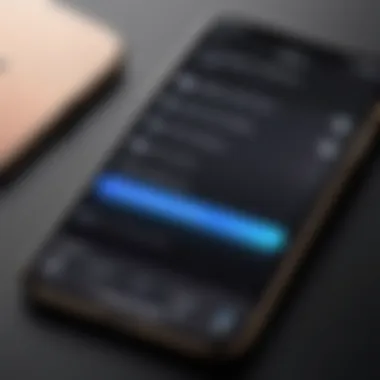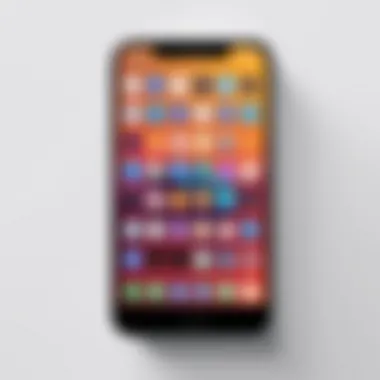Securing Privacy: Lock Hidden Photos on Your iPhone


Intro
In today's world, privacy is like a fleeting shadow—essential yet often overlooked. When it comes to smartphones, iPhones stand as icons of technology and user experience. Yet, hidden within these devices lie countless photos, many containing sensitive memories or personal moments. Knowing how to secure these hidden treasures can make all the difference in protecting one's privacy. Understanding methods to lock hidden photos can help users keep their personal lives just that—personal. This article aims to offer highly detailed instructions and thoughtful insights on steps to take right away, ensuring that the snapshots we hold dear remain unbothered by prying eyes.
Overview of the Technology
The iPhone packs a multitude of features geared towards user convenience and privacy. Among these, the photo library holds a special place, allowing users to store and manage their images efficiently. While the standard iPhone camera and photo apps serve their purposes well, hidden photos need additional layers of protection.
Key Specifications
When considering privacy features, the iPhone boasts a few specifications that cater directly to this need:
- Face ID and Touch ID Integration: These biometric security measures add layers of authentication, ensuring that only the rightful owner can access certain data.
- iCloud Integration: Allows for the possibility of encrypted storage, bolstering security when one accesses photos across devices.
Unique Selling Points
The ability to hide photos on iPhone is more than a simple click. Significant selling points include:
- User-Friendly Design: The photo app is intuitive, enabling users to hide photos quickly without requiring extensive instructions.
- Seamless Experience: The interaction between hiding and accessing photos feels fluid, showcasing the blend of technology and user experience that Apple is known for.
"Privacy is not an option, and it shouldn't be the price we accept for just getting on the Internet."
— Gary Kovacs, CEO of Privacy Corporation.
Practical Methods for Locking Hidden Photos
After outlining the technology's foundation, it is crucial to delve into concrete methods for securing these hidden photos. Users have a couple of built-in options within the iPhone’s ecosystem:
1. Using the Photos App
The Photos app has a hidden album feature. Here’s how you can utilize it:
- Open the Photos app.
- Select the images you’d like to hide.
- Tap the Share icon, then select Hide.
- Confirm, and these images will now reside in the Hidden album.
2. Hiding the Hidden Album
While hidden photos can be less visible, they still linger within the hidden album. To make them even more secluded:
- Go to Settings > Photos.
- Toggle off the Hidden Album option.
- Now, this album won’t appear in the Photos app, adding another layer of discretion.
3. Third-Party Apps
While Apple provides solid features, many users turn to third-party applications like KeepSafe or Private Photo Vault for enhanced security. Each offers unique capabilities:
- KeepSafe provides a pin code feature to protect access, creating an additional barrier against snoopers.
- Private Photo Vault allows for further organization with folders and a break-in report feature, alerting users about unauthorized access attempts.
Closure
In light of the digital age, ensuring the safety of your hidden photos weighs heavily on the decision-making of every iPhone user. By efficiently employing built-in privacy features and exploring well-reputed apps, one can substantially reduce the risks associated with digital privacy breaches. In summation, securing hidden photos isn't simply a matter of precaution; it's a cornerstone of preserving one’s personal narrative in an ever-connected world.
Understanding Hidden Photos on iPhone
In today's digital world, the images we take hold immense personal value. From family moments to secret snapshots, these photos tell our unique stories. With the rise of smartphones, particularly the iPhone, the capability to store and manage these images has evolved drastically. However, with this advancement comes the pressing need for privacy. Understanding how to manage hidden photos on your iPhone not only enhances your control over personal content but also fortifies your overall digital security.
Defining Hidden Photos
Hidden photos on an iPhone refer to images that users choose to seclude from general viewing within the Photos app. Apple introduced this feature to cater to the growing demand for privacy among its users. When you hide a photo, it gets moved to a specific album named "Hidden," making it less accessible to anyone casually browsing your photo gallery. Though this may seem like a straightforward solution, many overlook the nuances involved. For instance, hidden photos still exist in the iCloud backups, which may pose concerns for users keen on complete privacy. Therefore, knowing how the hidden photo feature operates is crucial for anyone wishing to maintain confidentiality regarding their visual content.
Importance of Privacy in Digital Images


Privacy in the realm of digital images is paramount. As more individuals engage with technology, the concept of personal space extends into the digital sphere. The importance of safeguarding intimate or sensitive photos cannot be overstated, especially in a time where data breaches make headlines almost daily.
"In a world driven by technology, personal privacy is not just a luxury—it's a necessity."
By securing hidden photos, individuals mitigate potential risks associated with unauthorized access. This consideration ranges from protecting personal memories to preventing blackmail or identity theft. With every photo stored on your iPhone, there's an underlying responsibility to ensure that those images stay safe from prying eyes.
Thus, understanding the implications of hidden photo features, and the essential steps to enhance privacy, is a pivotal aspect of modern smartphone usage.
Built-in Features for Photo Management
Understanding how to leverage the built-in features on your iPhone for managing photos is essential for anyone keen on maintaining their privacy. The iPhone offers a variety of tools designed to keep your photos, especially hidden ones, well-protected. These built-in features are beneficial because they don’t require additional apps or software, thereby minimizing complexities while maximizing efficiency. Relying on native functions also means that you get seamless integrations with the phone’s overall operating system. Moreover, they are designed with user-friendliness in mind, making them accessible even to less tech-savvy individuals.
Utilizing the Hidden Album
How to Access the Hidden Album
To access the Hidden Album, you need to navigate through some simple steps. Start by opening the Photos app, then tap on the Albums tab located at the bottom. Scroll down to the Other Albums section, where you’ll find the Hidden option. This method is straightforward; it lets users keep certain photos out of general view without much hassle. The hidden album is particularly handy because it offers an extra layer of privacy without needing complex security measures. However, while it provides some obscurity, it does not offer robust security, as anyone with access to your phone can easily view the hidden photos.
Moving Photos to the Hidden Album
Moving photos to the Hidden Album is another practical aspect of photo management on the iPhone. To do this, select the photo you wish to hide, tap the share button, and choose Hide. Confirm the action, and voilà, the photo is now tucked away neatly. This feature is popular because it offers quick and easy solutions for anyone wanting to declutter their visible albums whilst protecting sensitive content from casual onlookers. However, one must remember that this method relies heavily on simply being hidden and doesn’t prevent actual accesses, such as if someone knows how to navigate the Hidden Album.
Disabling the Hidden Album Visibility
In certain situations, you might want to go a step further in keeping your photos obscured. Disabling the visibility of the Hidden Album can add an extra layer of secuity. You can do this by going into Settings, selecting Photos, and then toggling the Hidden Album switch off. This means that the Hidden Album will no longer appear in the Albums view of the Photos app. By taking this action, you essentially enhance your privacy by ensuring that even the option to view hidden images is not accessible without going through the settings. Though this adds another step for you, it significantly heightens the aspect of secrecy and minimizes the risk of unintended discoveries.
Enabling Additional Security Features
In a world where our lives are increasingly documented through digital imagery, ensuring the security of sensitive photos on the iPhone becomes paramount. Without robust security measures, those cherished memories or sensitive images could potentially land in the wrong hands. By enabling additional security features, users can add an extra layer of protection, making it significantly harder for prying eyes to access what should remain private.
Using Face or Touch
One of the most convenient and advanced ways to secure your hidden photos is by utilizing Face ID or Touch ID. These biometric authentication methods transform your iPhone into a fortress for your media files.
Firstly, these features work seamlessly with the iPhone’s built-in applications, ensuring quick access while maintaining security. To set this up, navigate to the settings of your device:
- Go to Settings.
- Tap on Face ID & Passcode or Touch ID & Passcode depending on your device.
- Enable the option for Face ID or Touch ID for apps such as Photos.
"Using Face ID or Touch ID not only simplifies login but enhances security, making it nearly impossible for others to access your private images."
By enabling either of these features, you deter unauthorized access, as only your face or fingerprint can unlock the content within the hidden album. Given that we have our devices with us most of the time, this method strikes a balance between convenience and strong protection.
Setting Up a Secure Password
Aside from biometric methods, setting up a secure password provides another avenue for safeguarding your hidden photos. A well-constructed password serves as the first line of defense against unauthorized access. It’s essential to create a password that is both complex and memorable. Here’s how to establish it:
- Navigate to the Settings app.
- Select Photos.
- Under the Hidden Album, ensure that you have the option to require a password enabled.
When creating your password, consider using a mix of:
- Upper and lower-case letters
- Numbers
- Special characters
An example of a strong password could be something like “S3cureP@s$word!”. Avoid overly simplistic choices like "1234" or your name, as they can be easily guessed.
Remember, your password is your primary gatekeeper against unwanted viewers. It's a good practice to change it regularly and to also keep a note of it in a secure location, perhaps a password manager, for easy access when needed.
By integrating these additional security features into your photo management routine, you’ll gain better control over your personal data. Not only will your hidden photos remain private, but you'll find peace of mind knowing that your digital life is being safeguarded against potential threats.
Third-Party Applications for Enhanced Security
In the realm of digital security, third-party applications can serve as a robust complement to the built-in features provided by the iPhone. While Apple has integrated various functions to help protect users' hidden photos, a layer of additional security can go a long way in fortifying privacy. These applications often introduce specialized features tailored to the task at hand, making them indispensable, especially for individuals keen on safeguarding their personal images.


Choosing the Right Photo Vault App
When diving into the ocean of photo vault apps, it’s essential to pick one that aligns with specific needs. Here are a few criteria for selection:
Criteria for Selection
A fundamental aspect when choosing a photo vault app lies in app compatibility with your iPhone’s operating system. This ensures smooth integration and operation without glitches. One key characteristic is user interface simplicity; a clean, intuitive interface can significantly enhance the experience while interacting with the app. For instance, an app that allows easy uploads and location-specific organization can save users a lot of hassle.
One unique feature to consider is encryption technology. Look for apps that offer end-to-end encryption to ensure that even if someone manages to access your data, they can't decipher it. This not only adds a layer of security but also helps in maintaining peace of mind while storing sensitive images. However, it’s pertinent to note that powerful encryption can sometimes lead to slower access times, creating a trade-off between security and convenience.
Comparative Overview of Popular Apps
Next, examining popular apps can guide users who are unsure about which one to choose. Different applications not only provide various features but also cater to distinct user circles. One app that stands out is Keepsafe Photo Vault, known for its easy-to-use interface and robust privacy features. It's especially favored because it allows users to set up fake passwords, an excellent trick for keeping nosey folks at bay without compromising genuine access. However, extracting high-resolution photos from this app can be cumbersome, a consideration for those eager to retrieve pictures quickly.
Another notable tool is Private Photo Vault which offers password protection and options to hide videos as well. The appealing aspect here is the option for a break-in report, which takes a snapshot of anyone trying to access your vault without permission. That said, some users have expressed concerns regarding in-app advertisements, which might distract during daily use.
Setting Up a Photo Vault
After choosing the right app for your needs, the next step is setting it up effectively. This process generally involves downloading the app and following a straightforward registration process. Most apps usually require creating a password or using Touch ID, laying the first stone in building a protective wall around your photos.
When setting up, pay attention to the backup procedures—be sure the app allows you to back up your data to a secure location such as cloud storage. This is crucial to avoid any accidental deletions or data losses down the line.
Moreover, utilizing group folders can be beneficial. Many apps permit users to categorize photos under various themes or events, making it easier to manage hidden photos based on personal preference. This thoughtful organization not only enhances security but also improves usability, inviting a seamless experience when seeking to access one’s private images.
By employing a top photo vault app, you can transform your iPhone into a fortress for your personal images, effectively deterring unauthorized access and ensuring peace of mind.
In summary, integrating external applications dedicated to photo security can significantly enhance privacy on your iPhone, providing essential features that Apple's built-in options may not fully offer.
Best Practices for Photo Privacy
Maintaining the privacy of your photos is not merely a matter of clicking a button now and then. It’s an ongoing process, much like keeping your house locked when you aren’t home. Here, we’ll delve into effective strategies that not only secure your hidden photos on an iPhone but also promote a broader culture of digital privacy.
Regularly Reviewing Hidden Photos
It’s easy to forget what images we’ve stashed away for safekeeping. However, regular checks can make a realm of difference in keeping your data secure. Periodically evaluating your hidden photos can help you identify images that have lost their significance or could be shared safely.
Consider it like cleaning out your closet; sometimes, clinging to old stuff just takes up space. The process is straightforward:
- Open the Photos app.
- Scroll to Albums and tap on the Hidden Album.
- Go through the images and decide if they’re still relevant to hide or maybe even delete.
Adopting this habit ensures that sensitive data doesn’t linger longer than necessary. A cleaner hidden album not only eases navigation but minimizes potential exposure should someone accidentally access your device.
Keeping Software Up to Date
In the digital world, updates are imperative. Neglecting to keep your software updated is akin to leaving the front door ajar. Apple is consistently enhancing security protocols and patching vulnerabilities that could expose hidden photos. To guarantee that you’re fortified against unknown threats, perform these periodic actions:
- Enable automatic updates: Settings > General > Software Update > Enable Automatic Updates.
- Manually check for updates: Go to Software Update and see if any updates are pending.
By staying current with the latest updates, you not only bolster your iPhone’s defenses but also enjoy new features that could enhance your photo management experience. Remember, complacency is the enemy in any security protocol.
"Your privacy is in your hands. Regular practices ensure that hidden photos stay safe and sound."
In clenching down on good practices, you are well ahead in the game of photo privacy. Employing these methods can reduce the risks associated with digital imagery, making sure you're not just hiding, but securely managing your private moments.
Common Misconceptions About Hidden Photos
In today's digital landscape, many users fall prey to misunderstandings regarding the hidden photo features provided by devices like the iPhone. Knowledge in this area is crucial for anyone keen on safeguarding their privacy. Misconceptions can lead to a false sense of security, leaving personal images vulnerable or accessible to prying eyes. It's essential to recognize what the hidden album offers and to understand its limits.


Assumptions About the Hidden Album Function
A common belief among users is that the hidden album function is a foolproof strategy for protecting privacy. People often think once they move photos to this album, those images are entirely safe from others. However, the truth couldn't be further from that. The hidden album is merely a layer of obfuscation, not an impenetrable vault.
For example, it is crucial to note that anyone with access to your iPhone and basic familiarity with the interface can easily navigate to the hidden album. Even if the album is concealed, it's not password-protected by default, meaning anyone who can unlock your phone can view what's inside.
Here are a few misguided feelings regarding the hidden album:
- Complete Privacy: Moving images here does not encrypt them. They can still be found if someone knows where to look.
- Data Loss Prevention: Users often believe that hidden photos are immune from deletion or loss during updates or resets, which is false. Regular backups and checks are necessary.
- Automatic Security: Many users assume simply having hidden photos offers peace of mind. Security requires active management and awareness.
In reality, while the album can temporarily obscure photos, it cannot ensure total security unless combined with other protective measures.
Understanding Data Breaches
Another point of contention among users is the notion that their hidden photos are safe from data breaches. A common oversight is believing that utilizing built-in features from trusted devices like the iPhone guarantees absolute safety from hackers or malware.
With the rise of sophisticated cyber threats, relying solely on device features for security can lead to serious consequences. For instance, some users are unaware that if their iCloud is compromised, hidden photos can easily fall into the wrong hands. The hidden album does not provide robust encryption, so photos can be vulnerable.
Here are some considerations to keep in mind about data security:
- Remain Vigilant: Regularly change your passwords and use two-factor authentication where possible.
- Educate Yourself: Stay informed about the latest security threats and how to mitigate them.
- Secure Backups: Always ensure that your sensitive photos are backed up in a secure manner, preferably using encryption tools.
"The best defense is a good offense" – this saying rings true in digital security too. Regular check-ups and increased awareness can prevent untold headaches down the line.
The End: The Future of Photo Privacy
The evolving landscape of photography and digital storage emphasizes a pressing need for enhanced privacy measures. As photo-sharing becomes more effortless and instantaneous, ensuring the security of hidden images is not just about cautious behavior but also about adapting to the technological age. Consumers are becoming increasingly aware of the implications surrounding the privacy of their cherished moments. From sentimental family gatherings to sensitive personal milestones, the desire to protect these fragments of life is stronger than ever before.
Shifts in Consumer Expectations
Gone are the days when users passively accepted basic security features. Today's tech-savvy individuals demand more robust protections and transparency from their devices. As data breaches and hacking incidents flood headlines, a heightened awareness around digital privacy is evident.
- Users now expect:
- Enhanced encryption standards for stored images.
- Uncomplicated yet secure methods to access validated content.
- Clear, straightforward settings that inform users about their privacy options.
The demand for user-friendly interfaces that prioritize privacy reflects a significant shift in how consumers approach technology. This drive is reshaping not only how companies develop future software but also how they communicate with their user base.
The Role of Technology in Personal Security
Unquestionably, technology has a dual role in the realm of personal security. On one hand, it provides innovative solutions to safeguard private content; on the other, it poses challenges with ever-advancing methods of cybercrime. The introduction of features such as biometric security lets users take a giant leap toward securing their images.
Furthermore, as algorithms grow more sophisticated, offering individualized security measures becomes a possibility. This leads to tailored solutions that enhance the privacy of individual users based on their distinct habits.
"The paradox of modern technology is that it brings both protection and vulnerability; understanding this duality is key to navigating the future of photo privacy."
In closing, the future of photo privacy on devices like the iPhone is inextricably linked to the evolution of user expectations and technological advancements. By addressing these elements effectively, users can find solace in knowing that their digital memories are well-guarded.
Additional Resources for Further Learning
Keeping your hidden photos safe on an iPhone is essential, but the journey doesn’t end after you learn the built-in features and third-party apps available for added security. This section delves into the significance of continually expanding your knowledge through various resources. By tapping into diverse materials, you can stay updated with the latest trends, tips, and tools that concern digital privacy.
Online Forums and Communities
Online forums and communities serve as a treasure trove for users keen on enhancing their understanding of photo privacy. These hubs allow individuals to share their experiences, ask questions, and discuss challenges they face regarding hidden photos and privacy.
- Collaborative Learning: Engaging in discussions with like-minded folks who share common concerns can yield new insights. Users share personal tales, practical advice, and even pitfalls to avoid, which helps in making informed decisions.
- Real-Time Updates: Technology is no static affair. By participating in active communities such as on Reddit, you gain access to real-time information regarding new apps, iOS updates, and emerging threats. This immediacy is invaluable given how the digital landscape evolves.
- Support and Guidance: If you find yourself in a jam regarding features or specific functionalities on your iPhone, community members often provide much-needed support. This can involve anything from troubleshooting tips to personalized recommendations that suit your individual needs.
Official Apple Support Resources
Never underestimate the wealth of information available directly from Apple, the cornerstone behind your iPhone. Their official support resources are designed to provide users with authoritative guidance tailored for security.
- Step-by-Step Guides: Apple offers a range of detailed manuals about managing hidden photos and securing your privacy. These are usually laid out plainly, allowing even the less tech-savvy person to follow along effectively.
- Latest Updates: With the rapid advancement in technology, Apple frequently updates these resources in conjunction with their software upgrades. Users can find tailored insights specific to the iOS version they are using, keeping them aligned with new features or changes.
- Direct Support: If ever in doubt, utilizing Apple’s customer service can be an invaluable resource. They provide real, human guidance for users facing difficulties or needing specific help related to their devices.
By taking advantage of these additional resources, users can transform their approach to securing hidden photos. The richness of insights gained can provide not only immediate solutions but also equip you for future scenarios, thus ensuring your privacy remains intact in a technology-driven world.







